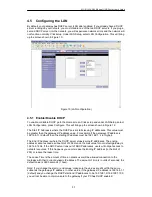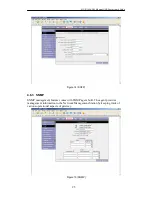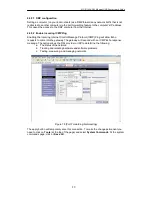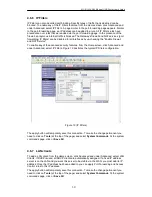
ATU-R140 ADSL Ethernet USB Router User’s Guide
26
The apply button will temporarily save this connection. To make the change permanent you
need to click on
Tools
(at the top of the page) and select
System Commands
. At the system
commands page, click on
Save All
.
4.6.4 IP QoS
IP QoS services in the NSP is applicable to the output device (Egress side). Meaning the IP
QoS traffic shaping is associated with any transmitted traffic from the perspective of the NSP.
Each output device has 3 priority queues associated with transmit data. The High priority
queue has strict priority over medium and low priority queues. The Medium and Low priority
queues are serviced on a Round Robin priority basis according to the configured weights
(WRR), after the High priority queue has been completely serviced.
The "IP QoS" section under "Advanced section" allows you to setup IP QoS for a connection.
The "IP QoS" section has two sub-sections - QoS Setup Page and Rule Setup Page.
4.6.4.1 QoS Setup
The QoS setup page allows you to configure IP QoS for a connection, to view the configured
QoS rules and to add/delete a QoS rule.
Choose a connection: This field allows you choose a connection from the list of available
connections. For e.g. Choose a WAN connection to enable IP QoS for the Upstream traffic of
the Modem. On the other hand choose the LAN connection (Ethernet and USB Bridged) for
the downstream traffic.
Low/Medium priority weights: These 2 fields will allow you to select the weights of the Medium
and Low priority queues in increments of 10 percent, so that that the sum of the weights of
these 2 queues is equal to 100 percent.
Enable IP QoS: This field allows you to enable/disable IP QoS for the chosen connection.
Trusted Mode: The NSP has two primary modes of operation with regard to queue traffic
prioritization - Trusted and Un-trusted. This field allows you to choose the mode - Trusted
(checked) and Un-trusted (Unchecked).
In "Trusted mode" all the rules will be applied first, regardless of the setting of the TOS bits.
After the rules have been exhausted the existing TOS bit settings will be honored. The "Un-
trusted" mode will match first against all rules as in "Trusted" mode. The difference is that if
there is no match then a default rule will be used. The default rule will have an associated
queuing priority - Low.
Rules section: This section displays a list of configured rules, allows you to add a new rule
and allows you to delete an existing rule.
Each rule is a Matching criteria that identifies an Application traffic to be transmitted by the
NSP using one of the 3 Priority Queues - High, Medium and Low.
Note: If IP QoS is enabled and no rules are defined, a Default Rule is added which is hidden.
The Default Rule puts all the Traffic to be transmitted in the Low Priority Queue.
Summary of Contents for ATU-R140
Page 1: ...USER MANUAL ATU R140 ADSL2 SOHO modem CTC Union Technologies Co Ltd ...
Page 2: ......
Page 44: ...ATU R140 ADSL Ethernet USB Router User s Guide 44 ...
Page 45: ......






























